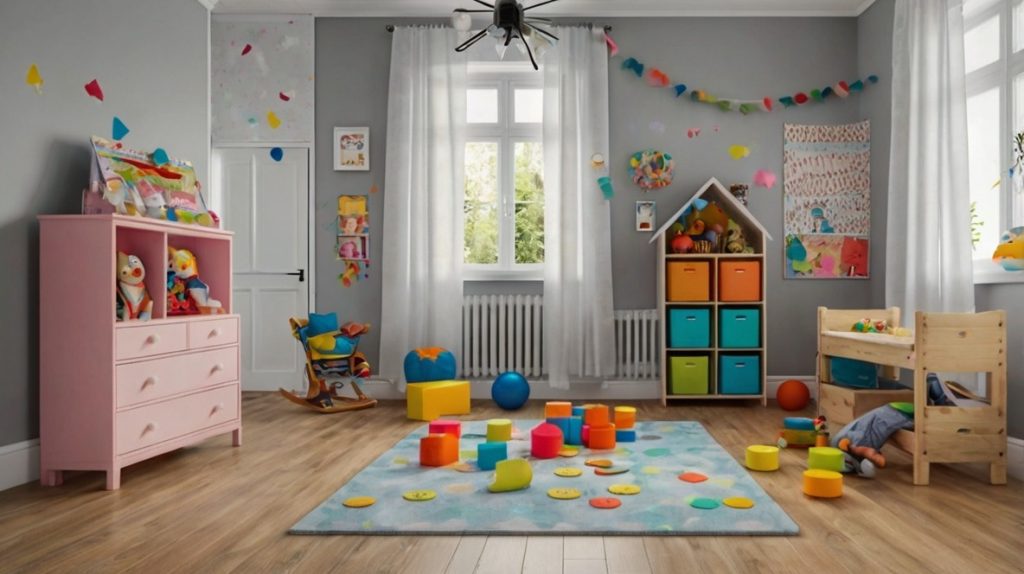
As a parent, I’ve learned that encouraging positive behavior in my child is key. A Reward System For Kids helps a lot. It makes parenting more fun.
A simple way to start is with a sticker chart or points for good behavior. Little kids get stickers for watching videos or reaching goals. Older kids earn points for helping out or being kind. They can trade points for fun things like more video game time or a little money.
Introducing a Reward System For Kids helps them feel responsible and motivated. It’s important to pick rewards they like. This keeps them excited and wanting to do well. As parents, we must be involved and consistent to help our kids succeed.
Key Takeaways
- Implementing a Reward System For Kids can encourage positive behavior and develop good habits.
- A Reward System For Kids can be tailored to a child’s age and interests, using methods like sticker charts or point-based systems.
- Behavior Rewards, such as tangible rewards or privileges, can motivate kids to complete tasks and demonstrate good behavior.
- Parental involvement is key for the success of reward systems, including maintaining consistency and providing timely feedback.
- Reward systems can help children develop a sense of responsibility, self-discipline, and self-motivation.
- Discussing suitable rewards with kids and considering their interests and preferences can ensure they stay motivated and engaged.
- Reward systems can be adapted to different age groups, including toddlers, preschoolers, and school-age children.
Why Traditional Punishment Methods Often Fail
When we talk about parenting, it’s key to know that old ways of punishing don’t always work. Behavior Rewards are better because they encourage good actions instead of punishing bad ones. Research shows that punishments can make kids feel scared, anxious, and resentful, not help them change.
Studies show that kids who get punished at home might break rules more when they’re out. This is because punishment makes them feel controlled from outside, not teach them to control themselves.
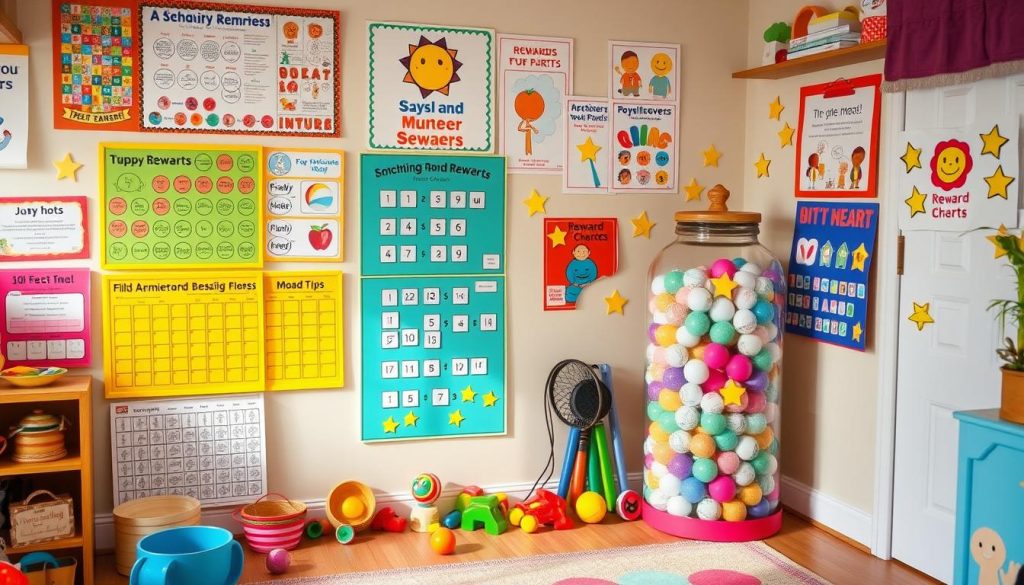
Unlike old punishment ways, Behavior Rewards aim to boost good actions like sharing and being kind. By praising and rewarding these actions, parents create a supportive space for kids to grow. We’ll see how setting up rewards can be fun and effective in the next part.
Setting Up Your Reward System for Kids at Home
Setting up a reward system for kids at home is fun for everyone. It helps parents and kids work together better. This way, kids feel more motivated and responsible.
A good chore rewards system teaches kids to be responsible. It shows them how important their help is at home. Use a chart or jar to track their progress and celebrate their wins.
When making rules, think about your child’s age and skills. A tiered system lets you adjust as they grow. Focus on rewards, not punishment, to encourage good habits.
To make a reward system for kids work, keep it fun. Offer special rewards and fun activities. With a bit of creativity, your child will learn to enjoy helping out.
1. Sticker Chart System
I’ve found that sticker charts are a fantastic way to motivate my kids to complete their tasks and follow good behavior. Each time they finish a chore, follow a rule, or accomplish something, they get to place a sticker on their chart. It’s a fun way for them to track their progress, and it’s visually rewarding! Once they reach a set number of stickers—like ten—they get a reward. Whether it’s extra screen time, a fun activity, or a special treat, the sticker chart makes the process interactive and keeps them engaged. I love seeing their faces light up as they fill up the chart!
2. Marble Jar System
I first introduced the marble jar system as a way to add excitement to everyday chores and good behavior. For every positive action, like helping with chores or showing kindness to a sibling, my child gets to place a marble in the jar. When the jar is full, it’s time for a reward! The best part is that the reward can be anything from a fun outing to a special dessert. This system is not only motivating but also allows them to physically see their progress, making the reward feel even more special. Plus, they love the sound of marbles clinking!
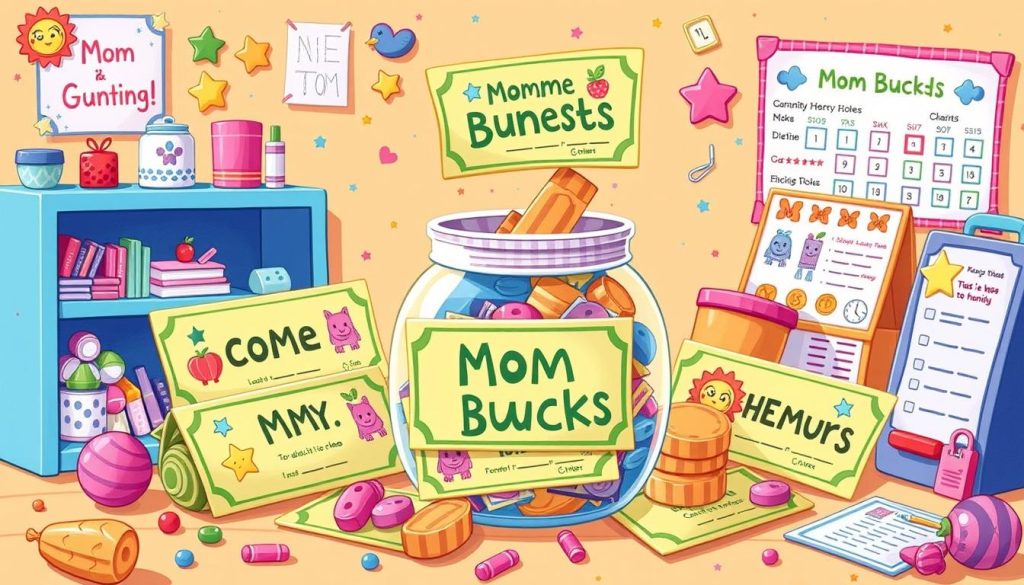
3. Point Systemn
A point system has been a great way for my kids to understand the value of their efforts. I assign points for different tasks like making the bed, completing homework, or cleaning up after themselves. They can accumulate points throughout the day or week, and once they hit a target, they get to redeem them for a fun reward, like a trip to the park or a new toy. It’s an easy way to track progress, and my kids love the idea of “earning” rewards. I’ve also found that they work harder when they see their points adding up!
4. Behavior Chart Systemn
The behavior chart system works wonders in reinforcing specific behaviors. I created a chart that lists behaviors I want to encourage, like using polite words, finishing meals, and staying in bed at bedtime. Every time my child does something on the list, they earn a reward like a star or a checkmark. At the end of the week, if they’ve met their goals, they get a bigger reward. This system helps them focus on particular areas of improvement, and it’s been a fantastic way to guide them in learning new habits while keeping it fun and lighthearted!
5. Treasure Box Systemn
The treasure box system is a hit in my home! I keep a small box filled with fun, inexpensive surprises like stickers, toys, or little activity books. Whenever my child accomplishes a task or shows positive behavior, they get to choose an item from the treasure box. It’s a fun way to add a sense of excitement and anticipation to everyday tasks. My kids love picking out a surprise, and it keeps them motivated to complete their chores. It’s such a simple system, but it makes a big difference in encouraging good behavior while making rewards feel like a little adventure.
6. Ticket Systemn
I love using a ticket system to make rewards more interactive. Each time my kids do something positive, like cleaning their room or sharing with others, they earn a ticket. These tickets can be saved up and redeemed for bigger rewards, like an outing to their favorite ice cream shop or a chance to pick a movie for family movie night. I keep the tickets in a jar, and they love watching them add up. The idea of “spending” their tickets on a fun reward gives them something to look forward to and helps them learn about earning rewards through consistent effort.
7. Weekly Goal Chart Systemn
The weekly goal chart system has been a great way to break down tasks and keep my kids focused. Each week, I sit down with my child and set achievable goals, like “read a book every day” or “help with laundry.” They earn rewards for accomplishing their weekly goals, like extra playtime or a special treat. I love that it teaches them about setting goals and working towards them while giving them clear, achievable milestones. Plus, it gives them a sense of accomplishment at the end of each week, which is a great confidence booster!
8. Daily Rewards Systemn
The daily rewards system is perfect for keeping my kids motivated on a day-to-day basis. I set up a simple checklist of tasks for them to complete, like brushing teeth, tidying up, and being kind to others. At the end of the day, they earn a small reward for completing their tasks, such as a sticker, extra playtime, or a small snack. This system makes it easy to stay on top of daily routines while reinforcing positive behaviors, and my kids love the instant gratification of receiving rewards for their efforts.
9. Chore Wheel Systemn
The chore wheel system is a fun way to add variety to daily chores. I created a wheel with different chores written on it, like “make the bed,” “water the plants,” or “help with dishes.” My child spins the wheel and then completes whatever task it lands on. Once they finish, they earn a reward like a special treat or extra time playing with toys. This system keeps things exciting because they never know which chore they’ll get, and it turns mundane tasks into a fun game. It also gives them a sense of control over their responsibilities.
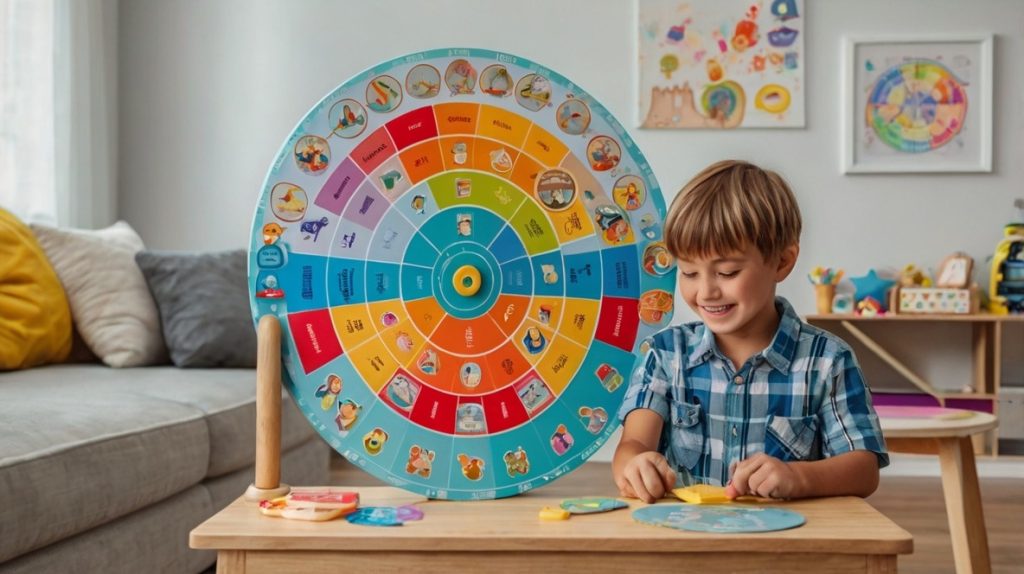
10. Reward Coupons System
Reward coupons have been a game-changer for us! I created a set of coupons for fun activities or treats that my kids can redeem after they complete certain tasks. For example, a coupon might say “1 extra story at bedtime” or “choose dinner for tonight.” My kids love collecting and “spending” these coupons, and it gives them something tangible to look forward to. It’s also a great way to offer rewards that feel personal and special, like an activity that we can do together as a family.
11. Family Fun Night System
I introduced a family fun night system where my kids can earn a special family night after they’ve completed their chores or displayed good behavior for a week. We’ll have a pizza night, play board games, or watch a movie together. It’s a reward they really look forward to, and it’s something the whole family enjoys. It’s a great way to spend quality time together while reinforcing positive behavior. Plus, it gives us a chance to bond and celebrate the week’s accomplishments as a family!
12. Praise Jar System
The praise jar system is a simple yet powerful way to motivate my kids. Every time they do something good, I drop a note of praise into the jar, acknowledging their positive actions. At the end of the week, they get to pick a reward based on how full the jar is. This system not only reinforces good behavior but also builds their confidence. It’s a great way to celebrate little wins every day, and my kids love reading all the notes of praise they’ve collected over time. It’s a great way to teach gratitude and self-worth!
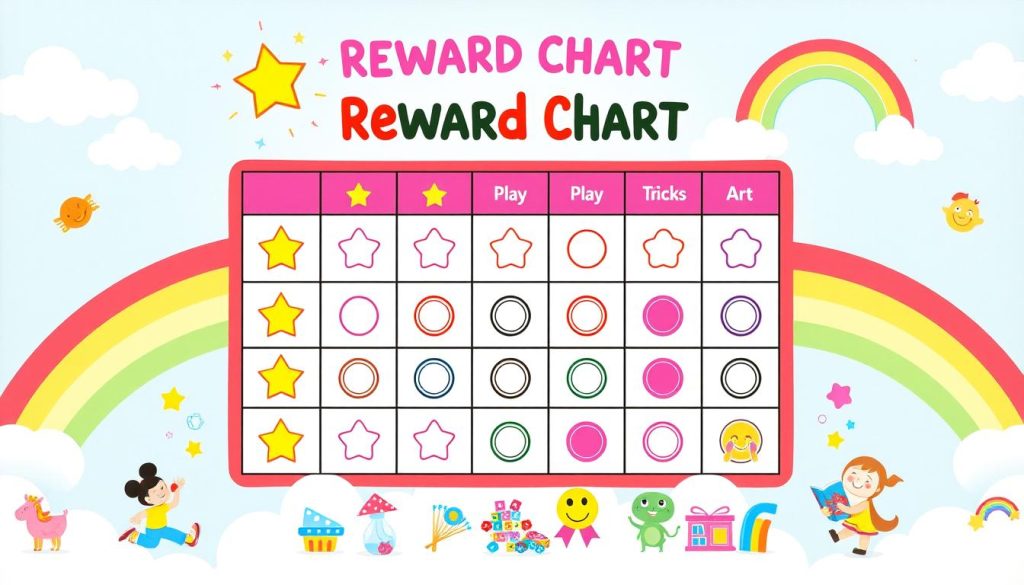
Adapting Your Reward System Over Time
When we start a reward system for kids, being flexible is key. Kids grow and their likes change. We need to update our chore rewards to keep them interested.
A reward system for kids works well at first. But, we must change it when needed. If your child stops caring, it’s time to rethink the rewards.
Signs It’s Time for a Change
Look out for signs like less excitement or motivation. If your child is not eager to earn rewards anymore, it’s time to change things.
Making Smooth Transitions
Involve your child in updating the chore rewards system. Ask them for ideas and work together. This way, you can keep them excited and motivated.
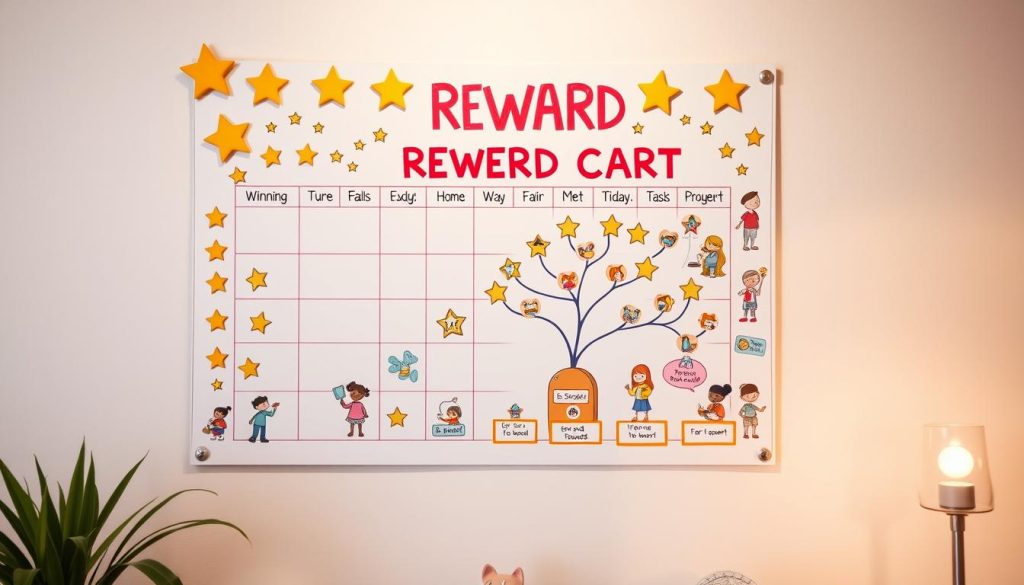
Handling Siblings and Different Age Groups
When we talk about reward systems for kids, we must think about siblings and age groups. In 82% of U.S. families with kids under 18, there’s at least one sibling. It’s key to have a fair and flexible reward system for each child’s needs.
Parents can set simple, clear rules for chore rewards. This helps younger siblings learn social skills and play together. Older siblings can show good behavior. Rewarding sibling kindness helps make their relationship better.
Doing an attention audit helps parents give feedback fairly to all kids. A reward system for kids can be made for each age group. Younger kids need more rewards, while older kids get bigger incentives.
By making a fair chore rewards system, parents encourage teamwork and responsibility. With patience and positive feedback, kids learn important life skills and feel good about themselves.
Creating Fair Systems
To make a fair system, parents should set clear rules and consequences. They should also give each child chances to earn rewards.
Individual vs Group Rewards
Parents can choose between individual or group rewards. Individual rewards help with personal responsibility. Group rewards encourage teamwork.
When to Phase Out Reward Systems
As we help our kids grow, it’s key to know when to stop using Reward System For Kids. This step is important for building inner motivation. It helps the good behaviors become a part of their everyday life.
For a smooth transition, use Behavior Rewards that mean something to the child. Start adding things like praise and recognition. This shows them their actions are valued, not just for the rewards.
Remember, every child is different. What works for one might not work for another. So, watch and change your plan as needed. Always aim to encourage good Behavior Rewards.
By carefully ending Reward Systems For Kids and adding more inner motivators, we help our kids grow strong. They learn to motivate themselves and see the worth of their actions. This helps them grow emotionally and socially too.
Conclusion
A reward system for kids at home is very powerful. It helps kids behave well and build good habits. Parents can use positive reinforcement to motivate kids to do their best.
There are many ways to reward kids, like extra screen time or special treats. It’s important to find what works best for each child. This way, they feel happy and motivated.
Being consistent is key to making good habits stick. It shows kids what to do and helps them feel secure. When we praise good behavior, kids want to keep making good choices.
The main goal of rewards is to help kids grow up well. They become confident, responsible, and smart. By using rewards, parents help their kids reach their full promise.




